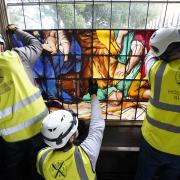From a woman unfortunate enough to be buried alive twice, to a mysterious Island manor house home to a variety of ghosts and ghouls, we uncover some of Hampshire’s most spooky stories
I have held an interest in ghosts, ghouls and the things that go bump in the night from an early age after my grandfather, a trawlerman who sailed from many locations, relayed fantastic tales of the supernatural to me. I first ventured to Hampshire in 2007 to Aldershot, then the home of the British army and in the declining stages of a large military town and was fascinated by its history and its impressive array of ghost stories. Here are some of my favourites from Aldershot and beyond.
The House of Old Mother Squalls

At the bottom of the long and steep Eggars Hill in Andover sits Weybourne Road. Beyond a railway bridge and on the border of Surrey you’ll find a charming and weathered house. The building is the previous site of the ancient Fox and Hounds Inn. Now a residential property, the house has a reputation for strange occurrences over the years. Some locals refer to the location as 'The House of Old Mother Squalls'.
According to local records, a woman lived here in 1640. She was considered by many to be a witch. Stories abounded of unholy activity carried out within the building. On more than one occasion Old Mother Squalls had provided evidence of a supernatural nature to anybody foolish enough to cross her. A story existed that the woman maintained the ability to plait a horse's tail instantly. She could twist a cow's tail just as quickly and terrify a dog or cat so the animals would flee with their tails between their legs.
On a dark and stormy night, Old Mother Squalls was summoned to help deliver a child. The woman who gave birth was Nell Gwynne, and the child's father was Charles II, but the illegitimate boy was stillborn. The infant’s body was buried beneath a yew tree in the grounds of nearby Church of St Michael the Archangel. It was a secret birth that could have changed the course of history and been the cause of anyone who was concerned with the affair losing their heads and Old Mother Squalls and all involved proclaimed a vow of secrecy.
There has always been a persistent rumour that The Church of St Michael the Archangel received a grant from Charles II. Legend states that the gift would continue if the yew tree flourished, but alas, the church records reveal no such transaction.
The sound of unexplained, unnatural footsteps along the path has been reported. Accounts exist from residents who claim to have heard strange shuffling noises in the confines of the church grounds. Tapping sounds akin to an older woman with a stick rattling the church window close to the famous yew tree are also documented.
The twice-buried alive woman

Alice Blunden resided in Basingstoke with her husband William. One day in 1674 a family member made a tragic discovery. Alice was found unconscious and unresponsive. Upon investigation it was found that she had been overindulgent in a beverage of the day called Poppy Water. The opiate based narcotic beverage was responsible for sinking her into a coma so deep that when her family summoned a doctor, a mirror placed below her nose failed to detect her breathing.
Her husband William was absent from the family home and away on business. His wishes to delay the funeral were refused due to the unusually warm weather and lack of cold storage and a coffin was hastily acquired to carry out the interment. Alice was described as: ‘A gentlewoman of sizeable girth’ and was alas too large for the coffin. When the undertakers attempted to bury her, they were forced to use oars to accommodate poor Alice into the coffin (indeed an undignified final descent).
Two days later a pair of local boys played within the grounds of Holy Ghost Cemetery, South View. The location complete with ancient ruins can make for an eerie setting even on bright, summer days. Although daytime, the two boys moved cautiously as they made their way home. While on the way to the rear exit the boys were drawn to a sound coming from a nearby wall. A terrifying moaning sound emanated from a newly covered plot. The children ran to their school master and informed him of the terrible sounds from the cemetery. Instead of investigating their claims they were punished for telling stories.
A full day later the headmaster’s curiosity would prevail. He travelled to the cemetery and immediately was drawn to pathetic whimpering cries from the grave of Alice Blunden. It would take several hours to organise help to dig up the grave. Mrs. Blunden, as could be imagined, was in quite a state when she was finally exhumed. She had bruises and blood all over her from trying for days to escape her burial plot and was so weakened from the experience that she had passed out. Rather than taking her to see a doctor, it was decided that she had, by now, expired.
A guard was summoned to attend Alice’s grave but through the night matters would go terribly wrong. The weather turned for the worse and a torrential downpour ensued. The guard gave up his post and hastily retreated to a nearby pub. This time Alice obliged everybody by finally passing away.
When the grave was uncovered the following morning, it was discovered that Mrs. Blunden had awoken during the night and, finding herself once more inside the grave, tore her face and hands to shreds in her panic to escape. She was not to be so lucky this second time, however, and her family discovered that this time, for certain, she was deceased.
A court case was brought forward by Alice’s husband. A charge of negligence against those responsible for the burial. Though being found guilty of murder was certainly a possible outcome, it was the testimony of the doctor of accidental death that saved those accused from the gallows.
A ghost village

The village of Hartley Mauditt sits one mile south of neighbouring East Worldham and two and a half miles southeast of Alton. The attractive Hampshire village rests in pleasant and calm surroundings. The one dividing factor here lies that Hartley Mauditt sits entirely abandoned and has done for hundreds of years.
A drive through nearby Selborne leads to a stretch of narrow, winding country roads. Upon entering a clearing, the village presents. All that exists of the once great location is a small church and pond.
The church was built between 1150 -1200 and had a suitably exciting history. A series of memorials feature within the Stuart family, whose Manor House stood next to the church before it was demolished. Local tradition says that the lord of the manor, Nicholas Stuart, defended the house during the English Civil War. Roundheads, fighting around the nearby town of Alton against a troop of Roundheads, came and destroyed it. Whether this is true or not, after the Restoration of Charles II as monarch, Nicholas Stuart received his lands back and became the first Baronet of Hartley Mauditt. Evidence suggests that the story is accurate, and for his loyalty, the King restored his land to him. He returned and rebuilt the house.
The Stuarts continued to hold the property for several generations until it passed into the hands of the Stawell family. Another local story tells us about Lord Stawell, who loved town and city life, but his country-loving wife preferred to live in Hartley Mauditt. In a rage, it is said, he pulled down the house to prevent her from living there. Whatever the truth, its staircase found its way to Alton council offices, floor tiles turned up in the floors at Colmore Rectory, and it is thought that the round tower, attached to a nearby cottage, was also once part of this old building.
Remnants of its cellars remain, wooded over and there are stories of a passageway linking the house to Selborne Priory. Many local tales abound of hauntings.
The name of the origin of the settlement is disputed. The family who initially held title over the lands was considered French and called ‘Maldnott.’ The village close to the church was long abandoned, but the outline of buildings can be seen at certain times of the year. A large village pond remains to remind us that the truth about the church and the land around it remains a mystery.
The village has a pleasant atmosphere even on the darkest of days. The still water of the pond rests calmly while the distant sound of bird’s echoes across the Hampshire countryside. When night-time arrives at Hartley Mauditt, however, so do its ghosts.
Over the years, witnesses have laid claim to some startling sights. The ghostly apparition of a phantom horse and carriage has been recorded several times. The ghost is seen travelling at frantic speed up the drive and towards the one-time location of the manor house, only to bypass the pond and then vanish out of sight.
Visitors have also reported the sound of enchanting singing emanating from within the church confines, only to be met with silence upon entering the long-abandoned church.
Whether the bizarre sights and sounds connect to the Stawell family is unknown. The manor house, now long gone, and the once active community of Hartley Mauditt exists purely as a ghost village.
The reappearing house

My favourite location for a visit is the spooktacular Isle of Wight. The title of ‘Ghost Island’ is indeed well deserved. The Isle of Wight features more ghost stories than any other island worldwide. The historic ghosts of Carisbrooke Castle, The haunted Ventnor Botanical Gardens, Spooky Shanklin Theatre and the smugglers favourite, The Buddle Inn. My favourite location is however long since gone.
The grand manor estate of Knighton Gorges is documented as being constructed in the 12th century. It was titled 'The Grandest Building on the Island' and encapsulated various stories. One of the earliest owners of Knighton was said to be Hugh de Morville, who, on the night of 29 December 1170, was one of four knights who murdered Thomas Becket at Canterbury Cathedral.
Between 1927 and 1977, there have been half a dozen recorded sightings of a ghost in the grounds. The apparition is that of Tristram Dillington and is sighted on 7 July, the date of his death. The terrifying spectral figure was sighted riding a horse and carriage throughout the grounds of Knighton Gorges.
Many visitors to Knighton Gorges stop and observe the great stone pillars at the entrance. The imposing construction is all that remains of house today. Visitors have described a host of decorative stone statues on the top of the posts for many years. Gargoyles, dogs, and other objects have all been described by members of the public. However, nothing remains and hasn’t for a long time.
The most intriguing story of all Knighton tales involves a peddler who dined and danced on New Years Eve in the manor house. The man was convinced that he had brought the New Year in accompanied by fellow revellers and enjoyed a thoroughly enchanting evening. The peddler stood astounded when furnished with the fact that the manor house had not existed for many years. Still today New Year revellers gather in the vicinity of the haunted pillars of Knighton Gorges, hoping to glimpse a brief sighting of the grandest building on the island. Lost in the mists of time, so many years ago. Another echo of the haunted realms of Hampshire.

John’s book is full of further ghostly tales and can be found on his site linktr.ee/johntantalon



























